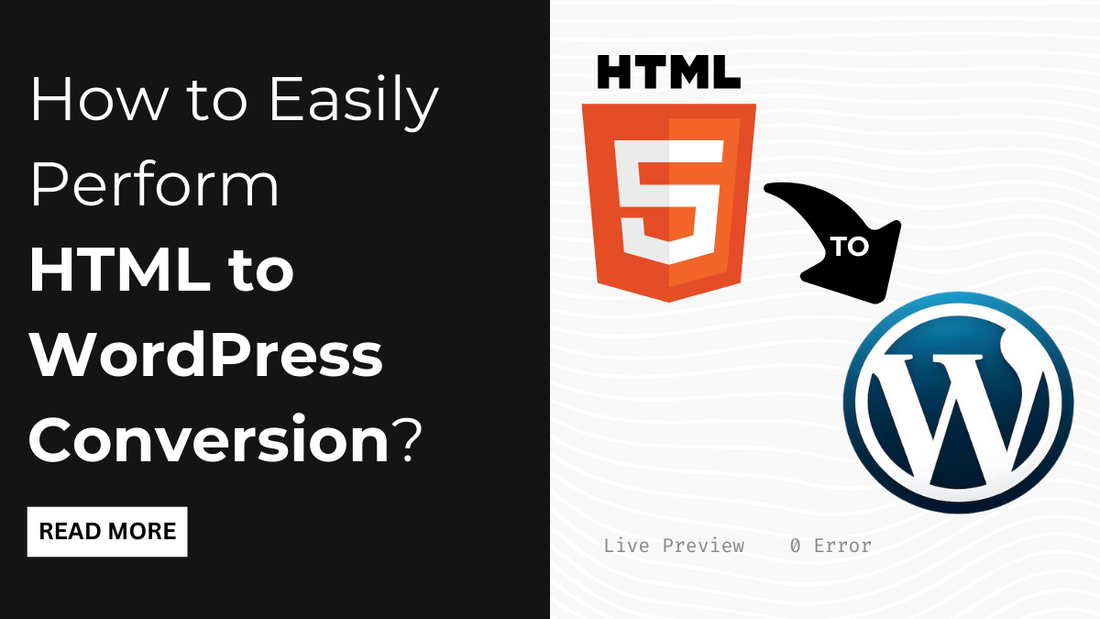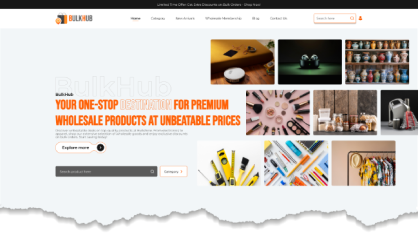
Introduction
Turning HTML into WordPress might sound daunting to a web development beginner. Still, it is achievable, provided one approaches it with the correct logic, as it converts your static HTML website into a completely dynamic and easily manageable WordPress website. Such conversion allows one to use the powerful WordPress content management system, making updates and maintenance way easier than editing the raw HTML code. In this blog, we'll take you through steps that will make the transition from an HTML site to a WordPress platform as seamless as possible. Be it upgrading functionalities, designer improvements, or even making managing your content easier, this step-by-step guide will walk you through how to make the conversion smooth and effective. Let's dive in and see just how you can pull off HTML to WordPress conversion with ease.
What is an HTML Site?
An HTML website can be referred to as a web page created using Hypertext Markup Language. It is thought to be the standard language used for structuring a web page. Simply put, HTML only defines the basic structure of content, incorporating texts, links, pictures, and many more elements. Each HTML document is a text file with the extension .html or .htm and consists of a series of tags and associated attributes, which indicate the arrangement and elements of the page. These tags are then interpreted by the web browsers to render the visual presentation of the site. HTML sites are static in the sense that the content is fixed and does not change unless manually updated. These are mostly used for simpler websites or single-page applications with minimal interactivity and content management. While HTML websites are easy to manage from the design perspective, they are static and do not feature the dynamic capabilities or content management of a modern content management system such as WordPress.
What is a WordPress Site?
A WordPress website is a site designed using WordPress, an open-source content management system that allows ease in the creation of a website. With its popularity, WordPress, one of the most flexible content management systems, has powered over a quarter of all websites on the internet. WordPress makes working with a website much easier by using an extremely user-friendly interface where one can easily publish content fast, especially for individuals and businesses not having extensive technical resources. The vast number of themes and plugins makes WordPress versatile for everything from blogs, portfolios, and e-commerce sites to corporate websites. It supports most media formats and natively includes optimizations for SEO, security, and performance. Besides, WordPress is open-source, which means it's always being improved by an international community of developers, who ensure that users are always up-to-date with the latest features and security enhancements.
Why Convert HTML to WordPress Website?
HTML to WordPress conversion offers several benefits that make it a smart choice for many website owners. Here are the detailed reasons why:
1. Dynamic Content Management
- Ease of Updates: HTML websites are static, requiring manual coding for each update. WordPress allows you to manage content through a user-friendly dashboard without needing to touch the code.
- Content Flexibility: WordPress provides tools like the Gutenberg editor and various page builders, enabling users to easily create, edit, and format content without coding.
2. Wide Range of Themes and Plugins
- Customization: WordPress offers thousands of themes and plugins, allowing you to customize the design and functionality of your site with ease. In contrast, modifying an HTML site requires detailed coding knowledge.
- Extended Functionality: With plugins, you can add new features to your WordPress site, like contact forms, eCommerce functionality, SEO optimization, and more. HTML sites require custom development to implement these features.
3. SEO Optimization
- SEO-Friendly: WordPress is built with SEO in mind. It offers plugins like Yoast SEO that make it easy to optimize your content, meta tags, and keywords. HTML websites need manual input to achieve similar SEO benefits.
- Mobile Responsiveness: Many WordPress themes are designed to be responsive, meaning your site will look great on mobile devices without extra coding. With HTML, you would have to manually write CSS or media queries for responsiveness.
4. Ease of Maintenance and Scalability
- Automatic Updates: WordPress regularly updates its core, themes, and plugins, which keeps your site secure and up to date. HTML sites require manual updates and code management so HTML to WordPress conversion is preferred.
- Scalability: WordPress is highly scalable, making it easier to add new pages, features, or integrations as your website grows, whereas HTML sites can become cumbersome to maintain as they expand.
5. Security
- Built-in Security Features: WordPress offers a variety of security plugins that can protect your site from malware, hacking, and vulnerabilities. Securing an HTML site requires custom coding and regular security audits.
- Community Support: Since WordPress is open-source, it benefits from a large community of developers constantly working to improve security and functionality. HTML sites rely solely on the expertise of the developer.
6. Easier Collaboration
- Multiple Users and Roles: WordPress allows multiple users to manage and contribute to your website, with different permission levels. For example, you can have administrators, editors, and contributors, streamlining the workflow. HTML sites require manual setup for multiple contributors.
7. Cost and Time Efficiency
- Faster Development: Once converted, managing and updating content in WordPress is much faster than hand-coding each change in HTML. This saves time and reduces long-term development costs.
- Lower Maintenance Costs: Ongoing maintenance of a WordPress site is typically cheaper than an HTML site, as most updates and customizations can be done through the platform’s interface.
8. Built-in Blogging Platform
- Content Creation: WordPress was originally designed as a blogging platform, so it comes with built-in features for creating and managing blogs. HTML requires custom coding for each blog post, making it harder to manage regular content updates. WHich is why HTML to WordPress conversion is suggested.
9. Integration with Third-Party Tools
- Seamless Integrations: WordPress easily integrates with a wide range of third-party services, including payment gateways, social media platforms, marketing tools, and analytics. These integrations can be complex to implement in an HTML site.
10. Future-Proofing
- Long-Term Viability: WordPress is continuously updated and evolves with web trends and standards. An HTML site can quickly become outdated unless you’re constantly coding to stay up to date with modern web practices.
So when you convert html website to WordPress, you ensure a more flexible, scalable, and user-friendly website that can easily grow with your business or personal needs.
3 Effective Ways to Perform HTML to WordPress Conversion
1. Manually Convert HTML to WordPress:
The steps involved in the manual migration of an HTML site to WordPress include design, development, and file management techniques in a series. Although cumbersome-sounding, the process can be followed through sequential well-set stages. In this way, you will be able to convert your static HTML site into a dynamic WordPress theme design while maintaining the design and content of your existing website.
(a) Preparation of Files
First, you will want to start by gathering up your current HTML website files into a single folder. Collect all the relevant files including but not limited to: HTML, CSS, images, and JavaScript. Your HTML site needs to be complete with proper formatting because, during the conversion process, you will be breaking those pieces down into consumable chunks for WordPress. Take this opportunity to create a backup of your HTML site so, if something goes wrong in your conversion process, you will have this to revert to.
(b) Setup Local WordPress Installation
First of all, create a WordPress setup on a local server before beginning the actual conversion. You can use XAMPP, WAMP, or MAMP software to create a local development environment. This way, you will be able to work on the conversion and not affect your live website. After setting up your local WordPress environment, it would be important to get familiar with the WordPress directory structure and how it handles themes.
(c) Adding a New WordPress Theme Folder
Open the wp-content/themes folder in the WordPress directory and create a new folder for your theme. You can name it as you like for your site; for example, "my-html-theme." You'll need to build some basic files in this folder for your new theme. The two most important files in your theme folder are index.php and style.css. The index.php will contain the central structure of your theme, while style.css will contain all of your styling information.
(d) HTML to WordPress Conversion with Template Files
WordPress themes are structured by breaking up the page into modular template files. Start by splitting your HTML file into a few smaller PHP ones; WordPress will then stitch these together to display various parts of your website. These typically include:
- Header (header.php): Take the HTML code that makes up the head section, the navigation menu, and all site-wide elements, and move it into this file.
- Footer (footer.php): Move the closing HTML tags and any footer content into this file. Sidebar (sidebar.php): If your HTML site has a sidebar, that's where it should go. Main Content (index.php): This is where the main content area of your HTML site will go. This is where WordPress will generate content dynamically.
Once the code is transferred, you will have to replace static elements by calling WordPress functions. For example, static navigation menus have to be replaced with the wp_nav_menu() WordPress function and the titles by calling the the_title().
(e) Add WordPress Functions
WordPress themes call dynamically with PHP functions for the display of content from the database. Now, in your index.php file, replace the static content blocks with WordPress loops. For instance, this is where the WordPress Loop will fall in to dynamically show posts or pages using the <?php if ( have_posts() ) : while ( have_posts() ) : the_post();)?. This step is crucial because it makes your theme dynamic, and your files database-driven.
Also, replace static metadata like the title and charset within the head section with WordPress functions. Example: wp_head() and bloginfo('name'). Call wp_footer() for the footer, allowing WordPress to inject scripts where it sees fit.
(f) CSS and JS Files
Move your CSS and JavaScript files to the respective theme folder. You need to enqueue those files using WordPress functions. You will include your CSS and JavaScript in the functions.php of your theme using the wp_enqueue_style() and wp_enqueue_script() functions. This would be critical in maintaining good loading order and creating minimal chances of conflicts with other plugins or themes in WordPress.
(g) Theme Testing
Now that your theme files are set up and WordPress functions have been incorporated, test your new WordPress theme. Now it's time to activate the theme in the WordPress backend and browse your site to ensure everything displays and functions correctly. Verify that your header and footer, content, and sidebars appear and that all dynamic items - like menus and posts - are displaying properly.
(h) Migrate Your Content
The last step is migrating your content onto WordPress from the old HTML website. For the tiniest of sites, you can easily copy and paste the text and media into the WordPress editor. For larger sites, use plugins or any tools allowing WordPress to import content on its behalf. You will probably have to redevelop any custom forms and other features with plugins.
Follow these steps, and you'll turn your HTML website into a fully functional, far easier-to-handle and maintain WordPress website. This is quite a detailed procedure that requires some acquaintance with the functions of WordPress. The end product will be a dynamic, extendable website powered by one of the most popular Content Management Systems in the world.
2. Use A WordPress Theme:
One of the most effective and user-friendly methods of HTML to WordPress conversion is by utilizing a WordPress theme. This approach is ideal for website owners who want to maintain the visual identity and design elements of their existing HTML site while tapping into the powerful functionality and scalability of WordPress. Instead of manually coding each page from scratch, using a WordPress theme simplifies the process, allowing for faster and more efficient conversion.
With this method, you can start by selecting a WordPress theme that closely matches the structure and style of your current HTML site. Many themes are designed to be highly customizable, meaning you can easily tweak design elements, layouts, colors, fonts, and more to mirror your HTML site’s look and feel. Beyond aesthetic customization, the shift to WordPress brings advanced content management capabilities, integration with powerful plugins, and access to a robust SEO framework all of which can significantly improve your site’s performance and search engine ranking.

One of the best options for this conversion process is by using a premium WordPress themes provider like VW Themes. VW Themes offers a diverse range of responsive, mobile-friendly WordPress themes that are ideal for HTML to WordPress conversion projects. These themes come equipped with demo content, which allows you to visualize how your content will appear within the WordPress framework and provides a starting point to streamline the migration. The themes are not only visually appealing but also optimized for fast loading times and built-in SEO, ensuring your website delivers top-tier performance.
Moreover, VW Themes offers extensive customization options, making it easy to align the theme with your brand’s identity, all while retaining the flexibility and scalability of WordPress. Our themes are intuitive, come with excellent support, and are designed for compatibility with a wide range of plugins meaning you can add features like eCommerce, social sharing, and more with minimal effort. By opting for a VW Themes solution, you get the best of both worlds: a quick and efficient transition from HTML to WordPress and a high-performing, modern website that’s easy to manage and update moving forward.
3. Use An HTML To WordPress Converter Plugin
These plugins make it easier for HTML to WordPress conversion. Such a plugin will automate most of the tasks that would otherwise involve technical experience and, therefore, enable one without a technical background to perform the conversion efficiently. Instead of having to manually code every aspect of your HTML website into WordPress, a converter plugin can take off a lot of heavy work by transferring the already existing structure, content, and layout into a WordPress theme format.
First of all, one of the major benefits of using a plugin for converting HTML into WordPress is the speed at which the operation is executed and how straightforward it can be. Most HTML to WordPress theme converter are pretty friendly: just upload your HTML file and the whole site migrates in an orderly step-by-step process. Such plugins convert your HTML into WordPress templates, maintain your site's content, design, and structure, and let you enjoy all the powerful features of WordPress. This saves loads of time compared to manually creating WordPress themes from your HTML code.
Most of these converter plugins to WordPress offer features for post-conversion customization. You can further tweak your new WordPress site by availing yourself of WordPress's very extensive customization options, plugins, and themes after the migration has been performed. With such flexibility, you are empowered to extend the functionality of your site, enhance its SEO, and carry out a raft of design edits. The beauty of it all is that you will not need advanced technical skills to make such adjustments, since WordPress' interface is intuitive and accessible to most users.
There are so many out there, that with this in mind, choosing an HTML to WordPress converter plugin should be done with careful consideration. Not all plugins provide equal functionality or compatibility with each type of HTML site. Before selecting a plugin, make sure it is reviewed highly, updated regularly, and that it supports the most recent version of WordPress. Other popular plugins available for import include HTML Import 2, which helps migrate static HTML pages into WordPress posts or pages, and WP All Import, which supports more complex conversions with custom fields and taxonomies. In that sense, an HTML to convert HTML to WordPress template serves as the perfect solution for a user whose goal is site migration without taking any headache about complex coding. The plugin made the process of conversion smooth, and quick, and enabled the users to fully utilize WordPress's vast capabilities while keeping the integrity of the original HTML website intact.
Conclusion
HTML to WordPress conversion is a practical way to upgrade your website, offering greater flexibility, ease of use, and advanced features. By following the steps outlined in this guide, you can efficiently transition your static HTML site into a dynamic WordPress-powered platform. Whether you opt for manual conversion using custom themes, employ a WordPress theme builder, or utilize plugins, each method ensures your site remains functional while taking advantage of WordPress’s extensive features. This conversion not only makes site management easier but also improves scalability and SEO optimization. With WordPress's powerful CMS and plugins, you can easily manage content, integrate eCommerce functionality, and customize your website to meet growing business needs.
One of the best ways to achieve a seamless transition is by using the WP theme bundle from VW Themes. The bundle offers a collection of professionally designed, responsive themes that are perfect for any niche. These themes are fully customizable, SEO-friendly, and come with demo content, making them an ideal choice for converting your HTML site into a WordPress-powered platform without sacrificing design or functionality.









